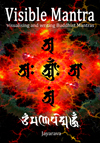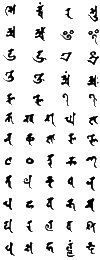
Sanskrit, and related languages, can be written in a wide variety of scripts - including Brāhmī, Karoṣṭhī, Gupta, Tibetan, and with some modifications Roman (the one we use to write English). Letters that use diacritics (the various dots, dashes and squiggles) when Sanskrit is transliterated are not as similar as their Roman equivalents might suggest - ta and ṭa are not the same! This is partly why diacritics are important. The Sanskrit 'alphabet' is not strickly speaking either an alphabet or a syllabary, but is what is known as an abugida or alpha-syllabary. It is made up of a mixture of single letter (eg the vowels) and the single consonants combined with the short a. A full syllabary would include all possible combinations of consonants and vowels, including conjunct consonants and would includes thousands of items.
Siddhaṃ was the script used to write the Buddhist scriptures that were transmitted to China. The practice of writing in the Siddhāṃ script was preserved in Japan by the Shingon school founded by Kūkai. On the right is an example of a Chinese brush Siddham alphabet by Kūkai. click for a larger image.
The Siddhaṃ Alphabet |
Siddhaṃ |
āli - the vowels
 |
 |
 |
 |
| a अ |
ā आ |
i इ |
ī ई |
 |
 |
 |
 |
| u उ |
ū ऊ |
ṛ ऋ |
ṝ ॠ |
 |
 |
 |
 |
| ḷ ऌ |
ḹ ॡ |
e ए |
ai ऐ |
 |
 |
 |
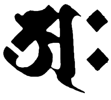 |
| o ओ |
au औ |
aṃ अं anusvāra (nasalised) |
aḥ अः visarga (aspirated) |
See also Combining vowels
Kāli - the consonants
* indicates there is an alternative way to write the syllable - see below
| unvoiced | voiced | nasal | |||
| plain | aspirated | plain | aspirated | ||
| Velar |  |
 |
 |
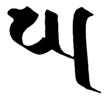 |
 |
| ka क |
kha ख |
ga ग |
gha घ |
ṅa ङ |
|
| palatal |  |
 |
 |
 |
 |
| ca च |
cha छ |
*ja ज |
jha झ |
ña ञ |
|
| retroflex |  |
 |
 |
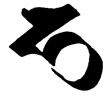 |
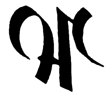 |
| ṭa ट |
ṭha ठ |
ḍa ड |
ḍha ढ |
*ṇa ण |
|
| dental |  |
 |
 |
 |
 |
| ta त |
tha थ |
da द |
dha ध |
na न |
|
| labial |  |
 |
 |
 |
 |
| pa प |
pha फ |
ba ब |
bha भ |
ma म |
|
| semivowels |  |
 |
 |
 |
|
| ya य |
ra र |
la ल |
va व |
||
| spirants |  |
 |
 |
 |
|
| śa श |
ṣa ष |
sa स |
ha ह |
||
| conjuncts | 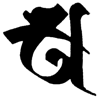 |
 |
|||
| kṣa क्ष |
jña ज्ञ |
See also how to write double and conjunct consonants
| Alternative forms |  |
 |
|||
| ja ज |
ṇa ण |

